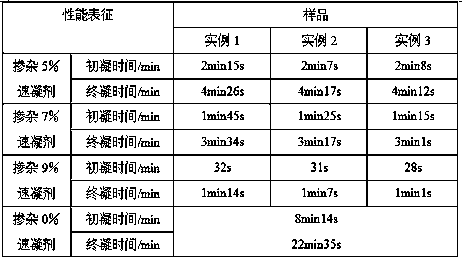Preparation method of alkali-free stable accelerator
An accelerator and alkali-stabilized technology, which is applied in the field of concrete materials, can solve the problems of low solid content, low stability, and low solubility of saturated solutions, and achieve the effects of improving solid content, breaking potential balance, and accelerating flocculation and coagulation
- Summary
- Abstract
- Description
- Claims
- Application Information
AI Technical Summary
Problems solved by technology
Method used
Image
Examples
example 1
[0020] According to the mass ratio of 1:10, polyethylene glycol 400 was added to N,N-dimethylformamide, stirred and mixed to obtain a mixed solution, and in parts by weight, 45 parts of the mixed solution, 10 parts of 2- Acrylamido-2-methyl-1-propanesulfonic acid and 3 parts of ethyl 4-acetylacryloylacetate were placed in a three-necked flask, stirred and mixed to obtain a base liquid, and the air was vented with nitrogen, and the rate of nitrogen gas was controlled to be 45mL / min, under a nitrogen atmosphere, and then in parts by weight, take 45 parts of base liquid, 6 parts of 2,2'-azobisisobutyronitrile and 3 parts of polyethylene glycol 2000 in a beaker, at 65 ° C After heating in a water bath for 3 hours, let it stand and cool to room temperature to obtain a gel base liquid; take the soil with a pH of 8.5 and a moderate saline-alkali soil, mix it with deionized water at a mass ratio of 1:10, and let it stand for 3 hours. Centrifuge and separate for 10 min at 1 / min, colle...
example 2
[0022] Add polyethylene glycol 400 to N,N-dimethylformamide at a mass ratio of 1:10, stir and mix to obtain a mixed solution, and weigh 47 parts of the mixed solution and 12 parts of 2- Acrylamido-2-methyl-1-propanesulfonic acid and 4 parts of ethyl 4-acetylacryloylacetate were placed in a three-necked flask, stirred and mixed to obtain a base liquid, and the air was vented with nitrogen, and the rate of nitrogen gas was controlled to be 47mL / min, under a nitrogen atmosphere, and in parts by weight, take 47 parts of base liquid, 7 parts of 2,2'-azobisisobutyronitrile and 4 parts of polyethylene glycol 2000 in a beaker, at 67 ° C After heating in a water bath for 4 hours, let it stand and cool to room temperature to obtain a gel base liquid; take the soil with a pH of 8.5 and a moderate saline-alkali soil, mix it with deionized water at a mass ratio of 1:10, and let it stand for 4 hours. Centrifuge and separate for 12 min at 1 / min, collect the supernatant to obtain saline-alka...
example 3
[0024] Add polyethylene glycol 400 to N, N-dimethylformamide at a mass ratio of 1:10, stir and mix to obtain a mixed solution, and weigh 50 parts of the mixed solution and 15 parts of 2- Acrylamido-2-methyl-1-propanesulfonic acid and 5 parts of ethyl 4-acetylacryloylacetate were placed in a three-necked flask, stirred and mixed to obtain a base liquid, and the air was vented with nitrogen, and the rate of nitrogen gas was controlled to 50mL / min, under a nitrogen atmosphere, and then in parts by weight, take 50 parts of base liquid, 8 parts of 2,2'-azobisisobutyronitrile and 5 parts of polyethylene glycol 2000 in a beaker, at 80 ℃ After heating in a water bath for 5 hours, let it stand and cool to room temperature to obtain a gel base liquid; take the soil with a pH of 8.5 and a moderate saline-alkali soil, mix it with deionized water at a mass ratio of 1:10, and let it stand for 5 hours, then place it at 3000r Centrifuge for 15 min at 1 / min, collect the supernatant to obtain ...
PUM
 Login to view more
Login to view more Abstract
Description
Claims
Application Information
 Login to view more
Login to view more - R&D Engineer
- R&D Manager
- IP Professional
- Industry Leading Data Capabilities
- Powerful AI technology
- Patent DNA Extraction
Browse by: Latest US Patents, China's latest patents, Technical Efficacy Thesaurus, Application Domain, Technology Topic.
© 2024 PatSnap. All rights reserved.Legal|Privacy policy|Modern Slavery Act Transparency Statement|Sitemap

